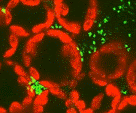Plant Pathology Department
Document Type
Article
Date of this Version
3-12-2019
Citation
2019 Dale et al
Abstract
Invasive alien species often have reduced genetic diversity and must adapt to new environments. Given the success of many invasions, this is sometimes called the genetic paradox of invasion. Phytophthora ramorum is invasive, limited to asexual reproduction within four lineages, and presumed clonal. It is responsible for sudden oak death in the United States, sudden larch death in Europe, and ramorum blight in North America and Europe. We sequenced the genomes of 107 isolates to determine how this pathogen can overcome the invasion paradox. Mitotic recombination (MR) associated with transposons and low gene density has generated runs of homozygosity (ROH) affecting 2,698 genes, resulting in novel genotypic diversity within the lineages. One ROH enriched in effectors was fixed in the NA1 lineage. An independent ROH affected the same scaffold in the EU1 lineage, suggesting an MR hot spot and a selection target. Differences in host infection between EU1 isolates with and without the ROH suggest that they may differ in aggressiveness. Non-core regions (not shared by all lineages) had signatures of accelerated evolution and were enriched in putative pathogenicity genes and transposons. There was a striking pattern of gene loss, including all effectors, in the non-core EU2 genome. Positive selection was observed in 8.0% of RxLR and 18.8% of Crinkler effector genes compared with 0.9% of the core eukaryotic gene set. We conclude that the P. ramorum lineages are diverging via a rapidly evolving non-core genome and that the invasive asexual lineages are not clonal, but display genotypic diversity caused by MR.



Comments
Phytophthora ramorum. mBio 10:e02452-18. https://doi.org/ 10.1128/mBio.02452-18.